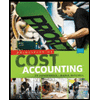6-29 Process Costing in Sugar Manufacturing The food-processing industry, like most process industries, is a common user of process costing. Consider, for example, the sugar manufacturing industry. The processes in sugar manufacturing can differ depending on the agricultural product used to produce sugar. When sugar cane is used, the sequence of processes looks something like this: First: Cane shredding The sugar cane is shredded into small pieces to facilitate its movement through the milling machine. Second: Milling The shredded cane is crushed between the rollers in the milling machine to produce the cane juice. Third: Heating and adding lime In this step, the cane juice is heated to concentrate the juice, and lime is added to reduce acidity. Fourth: Clarifying Impure elements are removed from the juice. Fifth: Evaporating and separating Here the juice is heated, vacuum is applied, and the liquid is centrifuged to remove the molasses and to produce what is called raw sugar. Sixth: Crystallizing The raw sugar is melted and carbon-filtered to produce the refined sugar. Seventh: Drying The refined sugar is dried and made ready for packaging. Due to the nature of the seven processes, there is a relatively large amount of Work-in-Process Inventory at any point in time. Also, sugar cane and raw sugar commodity prices can be stable for a period of time, but there are periods of high volatility caused by, for example, India's mandate in 2007 to develop ethanol fuel or the supply/demand imbalance in 1980 that sent prices up. Also, government price supports, import restrictions, and quotas affect the price of sugar cane. For example, as part of its development policy, the European Union (EU) in recent years paid above-market rates for sugar from a number of African, Caribbean, and Pacific countries, many of them former colonies of European countries. Required 1. Are firms that produce sugar likely to incur transferred-in costs? Why or why not? 2. Should a sugar producer use the FIFO or the weighted-average method for the process cost report? Explain your answer. 3. Identify and explain any sustainability issues for the production of sugar.
6-29 Process Costing in Sugar Manufacturing The food-processing industry, like most process industries, is a common user of process costing. Consider, for example, the sugar manufacturing industry. The processes in sugar manufacturing can differ depending on the agricultural product used to produce sugar. When sugar cane is used, the sequence of processes looks something like this: First: Cane shredding The sugar cane is shredded into small pieces to facilitate its movement through the milling machine. Second: Milling The shredded cane is crushed between the rollers in the milling machine to produce the cane juice. Third: Heating and adding lime In this step, the cane juice is heated to concentrate the juice, and lime is added to reduce acidity. Fourth: Clarifying Impure elements are removed from the juice. Fifth: Evaporating and separating Here the juice is heated, vacuum is applied, and the liquid is centrifuged to remove the molasses and to produce what is called raw sugar. Sixth: Crystallizing The raw sugar is melted and carbon-filtered to produce the refined sugar. Seventh: Drying The refined sugar is dried and made ready for packaging. Due to the nature of the seven processes, there is a relatively large amount of Work-in-Process Inventory at any point in time. Also, sugar cane and raw sugar commodity prices can be stable for a period of time, but there are periods of high volatility caused by, for example, India's mandate in 2007 to develop ethanol fuel or the supply/demand imbalance in 1980 that sent prices up. Also, government price supports, import restrictions, and quotas affect the price of sugar cane. For example, as part of its development policy, the European Union (EU) in recent years paid above-market rates for sugar from a number of African, Caribbean, and Pacific countries, many of them former colonies of European countries. Required 1. Are firms that produce sugar likely to incur transferred-in costs? Why or why not? 2. Should a sugar producer use the FIFO or the weighted-average method for the process cost report? Explain your answer. 3. Identify and explain any sustainability issues for the production of sugar.
Excel Applications for Accounting Principles
4th Edition
ISBN:9781111581565
Author:Gaylord N. Smith
Publisher:Gaylord N. Smith
Chapter19: Variable Costing (varcost)
Section: Chapter Questions
Problem 4R: To determine the effect of different levels of production on the company’s income, move to cell B7...
Related questions
Question
![Yuzu: Cost Manac X Q companies using X
Process Costing S X
a
Search
Are firms that pro x +
333/epubcfi/6/42[%3Bvnd.vst.idref%3Dchapter06]!/4/38/64/28/2[E6-29]/4/3:5[he%20... A
6-29 Process Costing in Sugar Manufacturing The food-processing industry, like most process industries, is a
common user of process costing. Consider, for example, the sugar manufacturing industry. The processes in
sugar manufacturing can differ depending on the agricultural product used to produce sugar. When sugar cane
is used, the sequence of processes looks something like this:
*
First: Cane shredding The sugar cane is shredded into small pieces to facilitate its movement through the
milling machine.
Second: Milling The shredded cane is crushed between the rollers in the milling machine to produce the cane
juice.
Third: Heating and adding lime In this step, the cane juice is heated to concentrate the juice, and lime is
added to reduce acidity.
Fourth: Clarifying Impure elements are removed from the juice.
Fifth: Evaporating and separating Here the juice is heated, vacuum is applied, and the liquid is centrifuged
to remove the molasses and to produce what is called raw sugar.
Sixth: Crystallizing The raw sugar is melted and carbon-filtered to produce the refined sugar.
Seventh: Drying The refined sugar is dried and made ready for packaging.
Due to the nature of the seven processes, there is a relatively large amount of Work-in-Process Inventory at
any point in time. Also, sugar cane and raw sugar commodity prices can be stable for a period of time, but
there are periods of high volatility caused by, for example, India's mandate in 2007 to develop ethanol fuel or
the supply/demand imbalance in 1980 that sent prices up. Also, government price supports, import restrictions,
and quotas affect the price of sugar cane. For example, as part of its development policy, the European Union
(EU) in recent years paid above-market rates for sugar from a number of African, Caribbean, and Pacific
countries, many of them former colonies of European countries.
Required
1. Are firms that produce sugar likely to incur transferred-in costs? Why or why not?
2. Should a sugar producer use the FIFO or the weighted-average method for the process cost report? Explain your
answer.
3. Identify and explain any sustainability issues for the production of sugar.
217](/v2/_next/image?url=https%3A%2F%2Fcontent.bartleby.com%2Fqna-images%2Fquestion%2F684b88a4-cf97-49e3-95f3-d49c39b0f437%2Fe4a75416-700c-4bf5-960d-5f7685a63cdd%2Fjijf6vi_processed.jpeg&w=3840&q=75)
Transcribed Image Text:Yuzu: Cost Manac X Q companies using X
Process Costing S X
a
Search
Are firms that pro x +
333/epubcfi/6/42[%3Bvnd.vst.idref%3Dchapter06]!/4/38/64/28/2[E6-29]/4/3:5[he%20... A
6-29 Process Costing in Sugar Manufacturing The food-processing industry, like most process industries, is a
common user of process costing. Consider, for example, the sugar manufacturing industry. The processes in
sugar manufacturing can differ depending on the agricultural product used to produce sugar. When sugar cane
is used, the sequence of processes looks something like this:
*
First: Cane shredding The sugar cane is shredded into small pieces to facilitate its movement through the
milling machine.
Second: Milling The shredded cane is crushed between the rollers in the milling machine to produce the cane
juice.
Third: Heating and adding lime In this step, the cane juice is heated to concentrate the juice, and lime is
added to reduce acidity.
Fourth: Clarifying Impure elements are removed from the juice.
Fifth: Evaporating and separating Here the juice is heated, vacuum is applied, and the liquid is centrifuged
to remove the molasses and to produce what is called raw sugar.
Sixth: Crystallizing The raw sugar is melted and carbon-filtered to produce the refined sugar.
Seventh: Drying The refined sugar is dried and made ready for packaging.
Due to the nature of the seven processes, there is a relatively large amount of Work-in-Process Inventory at
any point in time. Also, sugar cane and raw sugar commodity prices can be stable for a period of time, but
there are periods of high volatility caused by, for example, India's mandate in 2007 to develop ethanol fuel or
the supply/demand imbalance in 1980 that sent prices up. Also, government price supports, import restrictions,
and quotas affect the price of sugar cane. For example, as part of its development policy, the European Union
(EU) in recent years paid above-market rates for sugar from a number of African, Caribbean, and Pacific
countries, many of them former colonies of European countries.
Required
1. Are firms that produce sugar likely to incur transferred-in costs? Why or why not?
2. Should a sugar producer use the FIFO or the weighted-average method for the process cost report? Explain your
answer.
3. Identify and explain any sustainability issues for the production of sugar.
217
Expert Solution
This question has been solved!
Explore an expertly crafted, step-by-step solution for a thorough understanding of key concepts.
This is a popular solution!
Trending now
This is a popular solution!
Step by step
Solved in 4 steps

Knowledge Booster
Learn more about
Need a deep-dive on the concept behind this application? Look no further. Learn more about this topic, accounting and related others by exploring similar questions and additional content below.Recommended textbooks for you

Excel Applications for Accounting Principles
Accounting
ISBN:
9781111581565
Author:
Gaylord N. Smith
Publisher:
Cengage Learning

Principles of Cost Accounting
Accounting
ISBN:
9781305087408
Author:
Edward J. Vanderbeck, Maria R. Mitchell
Publisher:
Cengage Learning

Principles of Accounting Volume 2
Accounting
ISBN:
9781947172609
Author:
OpenStax
Publisher:
OpenStax College

Excel Applications for Accounting Principles
Accounting
ISBN:
9781111581565
Author:
Gaylord N. Smith
Publisher:
Cengage Learning

Principles of Cost Accounting
Accounting
ISBN:
9781305087408
Author:
Edward J. Vanderbeck, Maria R. Mitchell
Publisher:
Cengage Learning

Principles of Accounting Volume 2
Accounting
ISBN:
9781947172609
Author:
OpenStax
Publisher:
OpenStax College